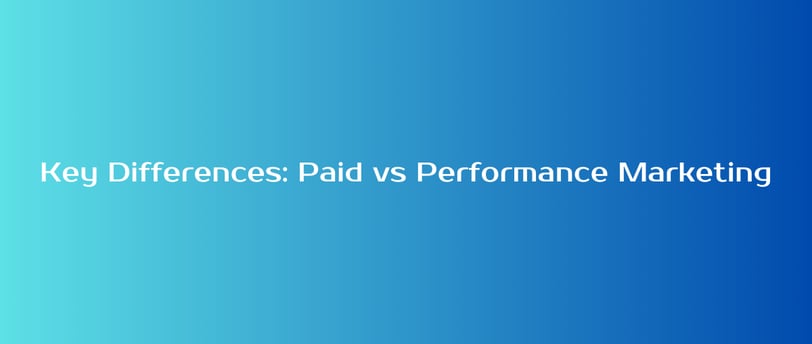Key Differences: Paid vs Performance Marketing
Discover the essential differences between paid marketing and performance marketing in our comprehensive blog. Learn about their unique approaches, benefits, and risks, and find practical tips to optimize your marketing strategy based on your business goals.
Gagan Gujral
10/21/20243 min read


In today's fast-paced digital landscape, businesses are constantly seeking effective ways to reach their target audiences and drive results. Two key strategies that often come into play are paid marketing and performance marketing. While they may seem similar at first glance, understanding their differences is crucial for crafting a successful marketing strategy. Let’s delve into the nuances of each approach and explore how they can impact your business.
What is Paid Marketing?
Paid marketing encompasses any advertising strategy that involves paying for ad placements across various channels. This can include traditional media, such as television, radio, and print, as well as digital platforms like Google Ads, social media ads, and display advertising. The primary focus of paid marketing is to reach a target audience, increasing brand visibility and awareness.
For example, a company might run a television commercial or a Facebook ad campaign to promote its products or services. While these ads can generate significant exposure, they do not guarantee immediate or measurable results, making it essential for businesses to track their performance and adjust their strategies accordingly.
What is Performance Marketing?
Performance marketing, on the other hand, is a more targeted approach where advertisers pay only for specific actions or results, such as clicks, conversions, or sales. This performance-based model emphasizes measurable results and return on investment (ROI), ensuring that businesses only incur costs when desired actions are achieved.
Common forms of performance marketing include affiliate marketing, cost-per-acquisition (CPA) campaigns, and pay-per-click (PPC) advertising. For instance, an e-commerce business might partner with influencers who receive a commission for each sale generated through their unique referral links. This way, the business only pays when it achieves a concrete outcome.
The key differences between paid marketing and performance marketing lie in their payment structures, measurement approaches, and associated risks. Paid marketing involves upfront costs for ad placements, focusing on impressions or reach to create brand visibility. However, this approach carries a higher risk, as there’s no guarantee of conversions or immediate results. In contrast, performance marketing operates on a pay-for-results basis, charging advertisers only for specific outcomes achieved, such as clicks or conversions. This model emphasizes measurable actions and allows businesses to minimize risk since payments are incurred only when desired results are realized.
Benefits and Drawbacks
Both strategies have their advantages and drawbacks. Paid marketing can provide broad reach and brand visibility, making it suitable for businesses looking to create awareness. However, it may not always result in immediate sales or leads.
In contrast, performance marketing allows for precise tracking and optimization, enabling businesses to maximize their ROI. However, it may require more in-depth analysis and continuous adjustments to campaigns to achieve desired results.
Current Trends in Marketing
As digital marketing evolves, the lines between paid and performance marketing continue to blur. More businesses are leveraging data analytics and AI to optimize their campaigns in real time, ensuring they get the most out of their marketing budgets. According to recent studies, performance marketing is gaining traction, with many advertisers preferring models that tie payments to measurable actions.
Practical Tips for Implementation
1. Define Your Goals: Determine what you want to achieve with your marketing efforts, whether it’s brand awareness, lead generation, or sales.
2. Choose the Right Strategy: Based on your goals, decide whether paid marketing or performance marketing is more suitable for your business.
3. Monitor and Adjust: Continuously track your campaigns' performance and be prepared to make adjustments based on the data you gather.
4. Leverage Data: Use analytics tools to gain insights into your audience's behavior and preferences, allowing you to refine your strategies.
Conclusion
Understanding the differences between paid marketing and performance marketing is essential for any business looking to navigate the digital landscape successfully. By leveraging the right strategy tailored to your goals, you can maximize your marketing efforts and drive meaningful results.
Have you experienced success with either paid or performance marketing? Share your thoughts and experiences in the comments below!
Services
Comprehensive solutions for your marketing needs.
Contact Us
Subscribe Now to Receive Exclusive Marketing Tips and Updates!
0091 9867000502
© 2024. All rights reserved.
